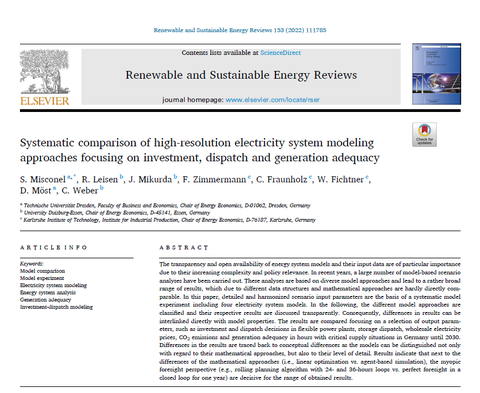03.11.2021
Neue Veröffentlichung: Systematic comparison of high-resolution electricity system modeling approaches focusing on investment, dispatch and generation adequacy
Together with researchers from the universities of Duisburg-Essen and Karlsruhe, Prof. Dominik Möst and Steffi Misconel published an open access paper on "Systematic comparison of high-resolution electricity system modeling approaches focusing on investment, dispatch and generation adequacy" in the Journal Renewable and Sustainable Energy Reviews. It can be downloaded here: https://www.sciencedirect.com/science/article/pii/S1364032121010546
The research for this paper was performed within the MODEX-EnSAVes project supported by the German Federal Ministry for Economic Affairs and Energy.
A huge thank you goes to the co-authors Florian Zimmermann, Robin Leisen, Jennifer Mikurda, Dr. Christoph Fraunholz, Prof. Dominik Möst, Prof. Christoph Weber, Prof. Wolf Fichtner.
Highlights
- Systematic comparison of four electricity system models.
- Analysis of differences in model results for a future German power system.
- Foresight perspective and mathematical approach influence model outcomes.
- Investments of at least 2.6 GW seem profitable in Germany in 2030.
- Need for 12 GW of additional flexibility to ensure generation adequacy in 2030.
Abstract
The transparency and open availability of energy system models and their input data are of particular importance due to their increasing complexity and policy relevance. In recent years, a large number of model-based scenario analyses have been carried out. These analyses are based on diverse model approaches and lead to a rather broad range of results, which due to different data structures and mathematical approaches are hardly directly comparable. In this paper, detailed and harmonized scenario input parameters are the basis of a systematic model experiment including four electricity system models. In the following, the different model approaches are classified and their respective results are discussed transparently. Consequently, differences in results can be interlinked directly with model properties. The results are compared focusing on a selection of output parameters, such as investment and dispatch decisions in flexible power plants, storage dispatch, wholesale electricity prices, CO2 emissions and generation adequacy in hours with critical supply situations in Germany until 2030. Differences in the results are traced back to conceptual differences as the models can be distinguished not only with regard to their mathematical approaches, but also to their level of detail. Results indicate that next to the differences of the mathematical approaches (i.e., linear optimization vs. agent-based simulation), the myopic foresight perspective (e.g., rolling planning algorithm with 24- and 36-hours loops vs. perfect foresight in a closed loop for one year) are decisive for the range of obtained results.

